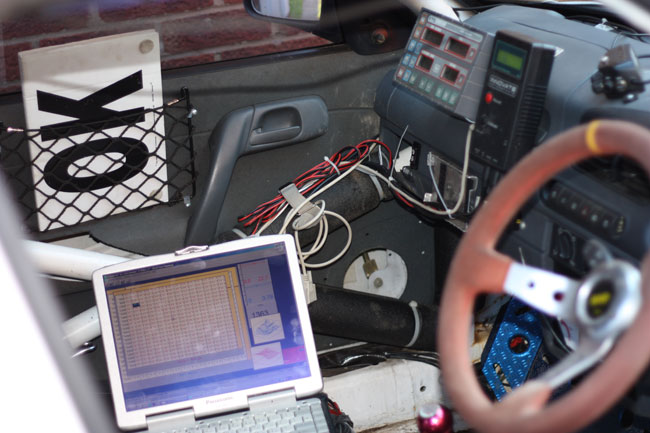Slacking off…
by Darren on Apr.16, 2012, under Seat
… is NOT what I’ve been doing. Although I’ve had the last couple of weeks off, I’ve been really busy, but mostly not with rally car-based stuff. However, I have not been completely lacking in progress. First thing, the Felicia passed the MOT last week, which was really my target to get done by the end of my time off, so that was good. For the most part, driving it was OK (aside from the freak hailstorm that happened on the way home, which was interesting on the tyres I was on – would have preferred either forest tyres or a Kayak!), but the mapping still needed work – there were a few flat spots here and there when driving in traffic or pulling away, and it was a bit erratic tickover-wise – sometimes it would be OK, other times it would just stall. Fortunately it played ball on the day, which was nice.
So, that left me with a bit of breathing space, and the rest of the time was taken up sorting out other issues (such as selling my Mum’s car for her, having MOT-ed it, so alas we only have one Felicia now), but today I’ve been able to get on with sorting out the mapping. Previously I’ve done this by using a datalogging device, and then analysing the data and then working from there. But the problem with that is that it needs a LOT of data, and there are some parts of the map which don’t get used a lot, so the analysis software doesn’t have enough data to work with. These areas are combinations of engine speed and load (i.e. throttle position), and in the case of these rare ones, they were clearly areas which get used when pulling away in traffic or from junctions, etc. – they were passed through briefly hence the old system not helping. So I decided to find them and then do the adjustments manually, which took a bit of juggling as I needed to left foot brake to keep the engine revs at a desired speed, and then adjust the throttle to find the flat spot. All of them were from too little fuel – in some places the mix was nearly half what it should have been – and once found were easy enough to sort out. As the day progressed, the map started looking better – it started out looking like the alps, and while it’s not super-smooth now, it’s much better, and the car is much better to drive. It’s still not got much guts under 3000rpm, but that’s because of the cam, I think – the fuelling is OK, so it’s either a lack of ignition advance (the other key parameter the ECU controls), or it’s just plain gutless. But the car won’t be being used like that, it’ll be given beans and always be “on the cam”, as they say.
Ignition timing is the other area that needs adjusting, and it’s trickier than the fuelling; with the fuelling I have got a device which measures the mixture and gives a readout of it, making mapping easy (or even possible!). But for the ignition timing it’s much trickier, as if the spark happens too early (too much advance) then the engine can get damaged very quickly, with pistons needing to be replaced at best. As a result, this isn’t something I’m going to mess with too much, but having looked at the map, I noticed that on full throttle around 4000-4800rpm the advance was much less than the surrounding areas, and that was the place where on full throttle there was a flat spot – the mixture is spot on, but there’s not enough power being made. So I took the brave/foolish decision to increase it to a more suitable (but still conservative) value, and gave it a go. Much better! It’s still a little flat there, but I’d rather err on the side of caution, and look into a way of measuring “knock” (i.e. too advanced a spark) before it’s too late, and leave it for another day to tune.
There has been another improvement; I’ve done some reading up, and taken people’s advice (particularly Dave Walker), and added in more advance below the desired idle speed. This has the effect of kicking the engine back up to speed if it goes to stall when ticking over, and I also discovered that idle mixture is important; previously I’d been told it didn’t make any difference, but doing this and getting the mixture right led to a car that finally ticks over on its own! This is great as not only does it tick over when left, but it also means that there’s no need for fancy footwork or use of the handbrake at junctions to leave a toe free to keep the engine going. The end result of this is that the car is much more pleasant to drive, particularly in traffic.
Here is the mapping setup (handily the Toughbook came with the Ibiza), and if you look carefully you can see the engine is still running, ticking over nicely. Splendid.
It’s still not finished, but it’s much better than it was, and fires up easily. The Ibiza uses the same ECU as the Skoda, and looking at its map shows the difference between the cars – the Ibiza map is smooth, looking like a nice hill from Teletubby land, whereas the Skoda one still has that “Craggy Island” look to it. But it’s never gone better, so it’s going in the right direction.


